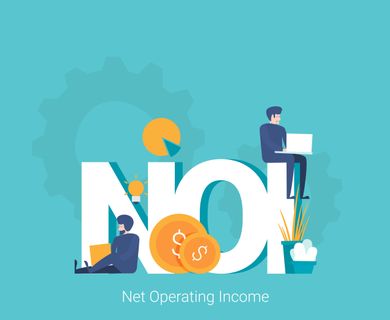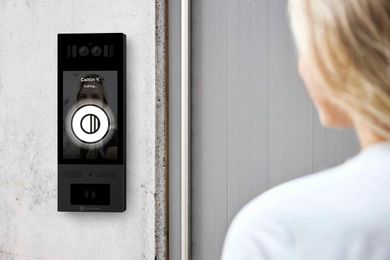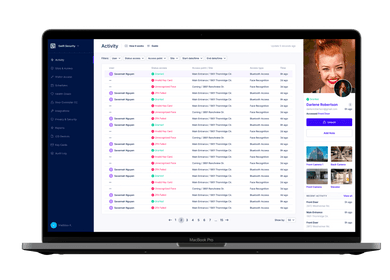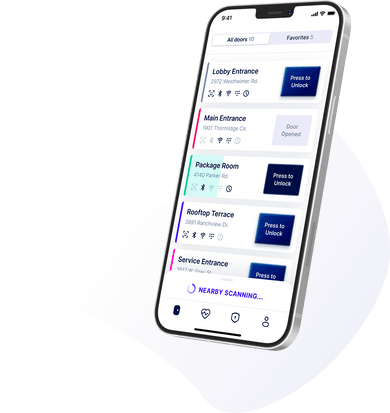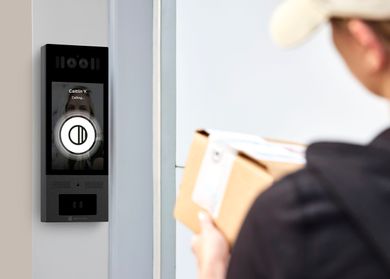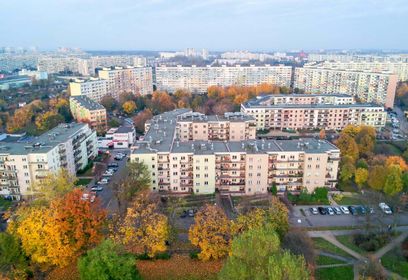Technology upgrades to security systems are converting a traditional operational cost center into a modern set of amenities. In a generation of tech-savvy renters and fierce competition to win them over, it’s no longer sufficient to simply find a single avenue to increase revenue.
Now, property management companies need to exhaust all of their resources to maximize their NOI in order to see the biggest return, the highest valuation, and the greatest amount of tenant satisfaction. Smart access control and cloud-based security systems are the unassuming solutions that apartment buildings and multifamily communities are using to scale success across their portfolios by increasing revenue, decreasing operations, and maximizing NOI.
Download our complete white paper to learn more about the smart building technology that apartment buildings are using to scale success across their portfolios to increase revenue, decrease operations, and maximize NOI.
Related Posts
- Best Smart Locks for Apartments
- Best Apartment Security Systems
- 10 Important Smart Building Technology Changes
- Apartment Intercom System: Ultimate Buyer’s Guide
- Best Face Recognition Access Control Systems
Table of contents
- What Is Smart Building Security?
- Best Apartment Security Systems
- Generating Income With Smart Access Control
- Decrease Operation Overhead With Smart Access Control
The Impact of Apartment Building Security on NOI
NOI Explained
Net Operating Income, or NOI, is the amount of revenue a property generates every year after expenses. This number is typically calculated by subtracting operating expenses from the total income generated.
There are two ways to maximize a property’s NOI. The first is by creating ways to increase revenue. This can take the form of increasing rent or implementing a revenue-generating amenity like laundry, vending machines, or business centers.
The second way to increase NOI is by decreasing operating costs. Typically, decreasing operating expenses (OPEX) requires more strategic initiatives like decreasing turnover, streamlining the turnover process or proactively repairing and maintaining the property.
Traditional Security Systems Drive High Operating Costs
Physical security has been slow to advance. However, recent years have seen rapid innovation in the technology that moves us through spaces, influences the way we interact with the environment around us, and operates physical security systems and protocols.
The more prominent physical security technology becomes, the greater impact outdated security systems have on decreasing NOI of apartment buildings or multifamily communities.
- Management Overhead of Traditional Security Systems
Security systems have traditionally required significant operating costs. For example, rekeying doors and monthly telephone line costs, and on-site management of key fob systems. Legacy access control and buzzer systems operate on-site. All of the data lives in local software on a local hard drive or simply within the security system hardware itself. Managing data locally consumes a significant amount of property manager time, not to mention if there are multiple buildings to manage.
Tenant turnover requires constant hands-on management of keys and making on-site updates to access credentials. Similarly, outdated intercom systems require manual directory updates. In addition, legacy intercom systems can only grant visitor access when someone is at the building. If a property manager needs to grant access to a contractor, maintenance, or cleaning staff, they need to be on-site to do so.
Further to that, the legacy software is cumbersome to use, requires technical training, and professional maintenance and updates. This causes significant friction during turnover.
- Reduction in Rental Pricing
Many factors influence rental prices, including how safe an area or neighborhood is. The property’s security system, on the other hand, has not traditionally been thought of as a major influencer. This is because apartment building security has been more or less the same from property to property throughout the years.
Now, even the perception of an outdated security system will deter good renters, drive rental pricing down, and ultimately reduce revenue.
- Security Risks
When tenants move out, many don’t return their keys or key fobs. Traditional key fobs have also become very easy and inexpensive to clone, which makes it impossible to know how many people have access to the building. Finally, legacy intercoms use a shared PIN that tenants pass out to everyone. It’s apparent that key management has become a time-consuming and expensive endeavor, but it’s necessary to maintain a security building for tenants.
- Package Management Expenses
E-commerce and online ordering have become a part of everyday life, which was only exacerbated by COVID-19. And properties are getting crushed under the volume of packages they receive for their tenants every day. Consequently over $6 billion worth of packages were reported stolen in 2020 alone.
Secure package delivery has become one of the main amenities that tenants not only prioritize but expect when they are looking to lease. So, property managers and staff now have to ensure that service is provided with constant hands-on management for deliveries, which causes significant operational overhead and cost to the property.
- Incurring Unnecessary Expenses
The maintenance, upkeep, and subsequent cost of legacy access systems increases property OPEX and drives NOI down. These costs include technician fees to update software and troubleshoot maintenance issues. Replacing key fobs, key cards, and garage door openers can add up to be a large expense as well. Most notably, outdated access systems are subject to security breaches and other issues, which leave the property open to huge liabilities to both their own building and their tenant’s property.
- Contribution to Tenant Turnover
Tenant turnover is a significant expense for multifamily buildings. Costs include making updates to the vacant apartment to attract new renters, marketing and new tenant acquisition efforts, and leasing staff hours. Reduction in revenue is also a major factor because every month an apartment sits vacant is one month of lost revenue.
At their best, outdated apartment security deters renters and potentially drives down rental prices. At their worst, they facilitate turnover and contribute significantly to the decrease of NOI. This can happen when a current access system is compromised and unauthorized access leads to vandalism or theft. And, it only takes one incident like this to drive good tenants away.
What Is Smart Building Security?
“Smart” building security is essentially a buzzword that can refer to many things. It’s important to define smart security to understand how to assess new access control technology for a building with the intent to maximize NOI. So what actually constitutes a smart security system in multifamily buildings?
Cloud-Based Management
Legacy apartment access systems operate on-premise, require manual software updates, and cannot be accessed from anywhere except on the local hardware that hosts the data. Smart access control — and any smart building technology — operates via an off-site server in the cloud. With cloud-based access control, data is more secure and can be accessed and operated from anywhere.
Mobile and Biometric Access Credentials
Smart access control systems use secure credentials that inherently require two-factor authentication for access. Traditional key card and key fob systems cannot offer another form of authentication, so there is very little insight into who is actually accessing the building. They are also often lost, stolen, forgotten, hard to manage, and easily cloned.
Mobile access control allows tenants to use their smartphones to unlock nearby doors within the network. Gaining access to a smartphone via passcode, fingerprint, or face ID provides another layer of security via two-factor authentication in order to access the building.
Even more advanced than mobile unlock is biometric access. Facial recognition access control is a touchless, keyless form of secure apartment building entry. Guided by both high security and privacy controls, face recognition entry is the very definition of a smarter access control solution. Tenants are able to self-enroll, which takes as little as 60 seconds. The platform and useability is intuitive to the digital generation. This mode of access also completely eliminates key management for property staff. And, most importantly, face recognition access supports the hands-free, hygienic-forward solutions that are critical in a post-pandemic world.
Video Intercom
Access control does not end with a list of authorized users. Tenants will have visitors, deliveries, dog walkers, and babysitters. Property managers will need to manage and maintain staff, contractors, cleaners, and prospective tenants. Smart access control thinks holistically about the entire building experience and facilitates seamless access for everyone.
Video intercom is an essential component of smart access control. The best access solutions will have built-in video intercom so that one cohesive platform manages all access events. Visitors use the tenant directory to call the resident who can pick up the incoming intercom call from anywhere, visually verify who is calling, and remotely unlock the door from the mobile app. Comprehensive video intercom solutions will also offer tenants the ability to send visitor passes to guests for on-time or multi-use access.
Integration and Interoperability
Previously, apartment building systems operated in their own vacuum. No two systems worked together, thus data and insights were incredibly limited. Managing each system separately took a significant amount of time and effort. Now, smart access systems support integrations with other building systems for seamless interoperability. And, the data collected from different sources provides valuable insights necessary for trend analysis that will support investment decisions.
The benefit of seamless, smart access control solutions is that property management can offer countless additional amenities to tenants. It enables flexibility, self-sufficiency, and most importantly, unparalleled security.
The idea of seamless, smart access control solutions are to enable a threshold over which property management can offer countless more amenities to tenants. It enables flexibility, self-sufficiency, and most importantly, unparalleled security.
Generating Income With Smart Access Control
According to the NHMC Disruption Report, the multifamily industry will have to build at least 4.6 million apartments by 2030 just to keep up with demand for apartment living. With record market demand, maximizing and expediting income and revenue will be critical.
Implementing smart access systems in new multifamily developments and upgrading existing systems in apartment buildings and communities is one of the simplest and most effective channels to increasing revenue.
Commanding Higher Rent
There are two ways to approach increased rent with the new, advanced access solutions on the market today. First, the very idea that by nature, a high-end, modern product will align with higher revenues. This is, of course, a hard statistic to track though on principle it holds true.
Second, a modern access and intercom product can be rolled into a technology bundle that is included in leasing contracts and rent payments. This technology package typically does not include access control by itself. Rather, it has other features such as internet or thermostat control. It’s a broader experience that provides the desirable amenities while still providing the resident a cost savings afforded by the buying power of the property. Creating this type of ancillary package is much more attainable to quantify and track, which makes it easy to show exactly what the revenue is and where it’s coming from.
Contributing to Higher Asset Valuation
Adding cloud-based apartment access to a technology bundle not only affects rent prices, but the way that the asset or property is valued as well. The bundle gets rolled into the actual pro forma to influence higher asset valuations.
Every dollar spent on smart building amenity upgrades can return a $20-$25 increase in rent monthly, which results in higher overall annual income from rent payments. As mentioned above, this can be either built into the pro forma of the rental agreement or added as a lease addendum or new amenity fee to more explicitly attribute the rent increase to technology improvements.
Tenant Retention Boosts Profitability
According to the Journal of Property Management, a retained tenant is worth about $900 per year in addition to rent payments. The average cost of tenant turnover is $1,750 per month but can be as expensive as $5,000. Similarly, the average length of time a unit sits vacant after a tenant moves out is a month and a half. If a tenant decides to stay and renew their lease, they save the property $2,625 (based on average turnover cost and length of vacancy) in turnover fees and lost revenue. They also save the property marketing expenses and other overhead costs associated with tenant acquisition.
Integrating a modern, cloud-based access system with flexible and convenient video intercom capabilities drastically enhances the tenant experience by providing tenants with the amenities they want and need and curates a safe living environment. All of these efforts contribute to the retention of good tenants and subsequent profitability.
The Tenant Experience
Now more than ever, the tenant experience is a major factor that contributes to retention. As working from home becomes the norm, it’s more important than ever for tenants to be able to build a community and love the places they live. For property management companies, the key to retention will live in the details that show residents they care about their environment and well-being. This will look like genuine concern over secure package delivery, ease of access to the building and amenity spaces, thoughtful consideration for visitor and guest access, and more.
Upgrading to a modern access system allows property managers to cultivate this experience for their residents under one platform. It gives residents the control and flexibility they want while maintaining the highest level of security. All of this contributes to the investment in strong tenant retention and loyalty.
Safe Living Environment
Safety, security, and peace of mind are the most important factors for renters. And technological advances in access control are able to create even safer living spaces for tenants.
Mobile unlock and face recognition access far surpass fob and key card access in both sophistication and security. While key cards and fobs can be easily stolen and cloned, mobile and face recognition have inherent two-factor authentication for an extra layer of security. Cloud-based management and remote operating capabilities make it simple for properties to grant and revoke access leaving no gaps in security when it comes to maintaining authorized credentials to the building.
Video intercom systems are also far more secure than traditional buzzer systems. Tenants are able to see who is at the door before letting them in via mobile unlock. Modern video intercom systems also give tenants the ability to issue single- or multi-use visitor PINs that can be scheduled or revoked at any time. By issuing unique PINs to different visitors, tenants no longer have to worry about distributing their own permanent PIN and risking unauthorized use.
Increase Rate of Lease Conversion
It’s inevitable — tenant turnover will happen. But, smart access is providing property management companies with a solution to expedite leasing and minimize loss of revenue when it does.
With smart access, properties can offer seamless, contactless self-guided tours and self-showings to prospective renters. Cloud-based access control systems allow admins to generate and share unique visitor passes from anywhere. Visitor passes can be scheduled to grant access during specific days and times to accommodate the schedules of the prospect and save property staff time.
In 2018, a leasing activity analysis by Anyone Home showed those who used self-guided tours converted to a lease agreement at nearly twice the rate—9.3%vs. 5%—than those who didn’t. According to more recent data from NMHC, self-guided apartment tours increase lease conversions by 86% versus those escorted by property staff. And property management professionals are catching on as the culture of apartment leasing evolves.
In reference to self-guided tours, Dionne Van Druff, vice president of Property Management at Mill Creek Residential says, “Customers are more self-sufficient than ever before and continue to demand increased speed and convenience.” By offering self-guided tours that allow renters the freedom and flexibility to engage with the building and imagine it as their own, property managers put themselves ahead of the competition. And the results are in the numbers. Since Mill Creek’s launch of self-guided tours at one of their properties, 60% of first-time prospects choose to take a self-guided tour over one with an associate.
Decrease Operation Overhead With Smart Access Control
Generating new revenue and increasing existing income avenues are just one component of net operating income. In order to completely maximize NOI, property management companies also need to simultaneously reduce operational overhead and cost.
With the flexibility and convenience afforded by smart access systems, property managers and building owners are able to seamlessly implement those practices across their portfolios.
- Remote-First Management
Properties require constant hands-on management. Package management, for example, is just a small portion of property staffer’s responsibility. But, 68% of building staff spend up to four hours a week managing packages alone. In 2015, Camden Property Trust estimated that across its 59,000 units, 10 minutes of productivity was lost per package received. If an employee is paid $20 an hour, this equates to a cost of $3.3 million annually for package management.
That same principle for on-site package management can be applied across most property tasks, including key card or key fob management, granting access to maintenance or contractors, performing property tours, and more.
Smart access in apartment buildings enables a flexible operation that significantly reduces the overhead required to operate a property day to day. The ability to manage access for tenants and visitors remotely liberates both property managers and their employees from redundant, time-consuming responsibilities that have the potential to scale to massive overhead costs.
- Intuitive Interface and Platform
Legacy access systems run on outdated software that is hard to understand, which requires additional technical training. It also requires manual software updates on local hardware. These updates are frequently overlooked and professional support is eventually needed to troubleshoot issues. Not only that, the updates become so drastic that users have to spend time and additional training in order to learn the nuances of the newest version of the software.
Inherently, this is a cumbersome process for property managers and staff. When factoring in staff turnover rates and repetitious onboarding, it becomes even more time-consuming. Antiquated technology such as this does not align with the tech-savvy nature of most systems in use today.
The objective of smart building technology is to save time in a time-poor culture. This is exactly what smart access is meant to do for large operations like property management. Smart access systems are built with intuitive interfaces that make sense to the end user and mirror how we interact with and use technology today. It requires no technical training or additional technical skills to operate, and employee onboarding is minimal. Cutting back on unnecessary inefficiencies like juggling antiquated technology reduces property overhead and minimizes barriers to operations.
- Facilitate Seamless Scalability and Property Acquisition
Scaling up a portfolio to include more properties is a key component to significant cash flow. So, it comes as no surprise that Real Capital Analytics reported that real estate investors purchased $53 billion of multifamily real estate between April and June of 2021. This is a massive uptick from the $20 billion worth of multifamily real estate investments made in the same quarter just a year prior, though the COVID-19 pandemic is partially to blame.
And while the benefits of property acquisition far outweigh the pain points, property management and real estate development companies still face significant hurdles when taking over a new building.
One of the first tasks during a property acquisition is learning the physical security practices and patterns. This includes the nuances of the existing security systems and integrating existing company protocol into them. Smart access makes this practice incredibly simple. Multiple buildings can be managed under just one platform, and admin credentials are remotely transferable. The advanced reporting and auditing capabilities also facilitate a frictionless understanding of the tenants and building traffic, which is typically an extensive task for incoming managers, if possible at all.
Overall, smart access and smart building technologies streamline property expansion in areas where it was once severely inhibited. The smooth transition and scaling process limits barriers to growth and the operational overhead that comes with it in order to contribute to the positive impact on NOI.
- Data-Informed Insights and Decision-Making
With the historically slow adoption of technology in real estate, property data is not great. Or at least as great as it could be. As the multifamily industry increasingly uses data to drive much of the decision-making, this is a problem.
According to Globe St., “45% of CRE teams are spending at least 15% to 25% of their time managing and organizing data.” Additionally, the majority of CRE firms (8 out of 10) have an executive position dedicated to data strategy and governance. This is true of major property management companies and real estate development firms.
This tells us two things: data is critically important. But the means by which it’s being collected, analyzed, and used is far from effective and efficient.
Collecting data is easier said than done. Fragmented data sources lack communication with one another. And, data management is complex overall. But, this is the major distinction between legacy access solutions and modern, smart access control systems — with the syndication, tracking, and analysis of real-time data.
Incorporating real-time data for property evaluation streamlines the data collection process and creates invaluable insights. Once properties evaluate what data is important to meet business goals, they can start to invest in the appropriate solutions and practices. With this data, decisions can be monetized and implemented, which takes the guesswork out of tenant experience investments or any other.
- Enable a Growth-Based Mindset
Having a physical security system with remote-first management, an intuitive interface, streamlined scalability, and in-depth data insights fall under the umbrella of this final consideration. Each of these benefits significantly reduce OPEX in order to enable a growth-based mindset for property managers and owners.
Streamlining tasks and minimizing operational overhead allows property staff to focus their time and efforts on growing value and improving the real estate investment overall. Competitive tenant acquisition marketing and leasing efforts are far more fruitful to building value than the tedious tasks required to maintain legacy systems. Continued community building and focusing on improving the tenant experience are key retention initiatives that contribute to improving building valuation.
By investing in initiatives that improve the property investment as opposed to ones that simply keep the building up and running, properties can yield the maximum amount of value and thus NOI.
Request A Demo
If you are interested in learning more about Swiftlane's video intercom system, please tell us your questions and we are happy to help out.

